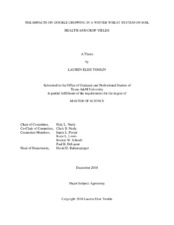The Impacts on Double Cropping in a Winter Wheat System on Soil Health and Crop Yields
Abstract
Double cropping can increase farm profit and food availability, and may improve soil function by sustaining year-round vegetation and building soil organic matter. However, replacing summer fallow with warm-season double crops in an annual winter wheat cropping system may not sustain subsequent wheat yields due to increased water use with cropping intensification. Reducing tillage may abate soil water deficits generated by double cropping and could allow persistence in water limited environments. Our objectives were to evaluate cropping system and reduced tillage effects on soil physical properties and soil moisture, and to quantify these cropping systems using crop yields and herbage mass production. Following winter wheat harvest, a summer treatment of fallow, sesame, grain sorghum, cowpea, and a nine-species cover crop mix were evaluated under three tillage treatments (conventional, strip-till, and no-till). Study locations included Beeville, Thrall, and Lubbock and was implemented in fall 2015. At Lubbock, soil water deficits created by sesame and sorghum at the time of wheat planting were shown to decrease subsequent wheat yields by 12% and 45%, respectively, compared to fallow. Double crops impacted soil water during the growing season, and success of subsequent wheat crop was dependent on soil water profile recovery via precipitation/irrigation in time for wheat planting. Soil water differences became less evident as the wheat growing season progressed, and Thrall’s subsoil was much sooner to recover than Lubbock. Tillage made less impact on crop yields and biomass production in Thrall and Beeville in relation to soil moisture, but it was evident that reduced tillage may be imperative in semi-arid regions such as Lubbock, as wheat yields were significantly affected by water deficits at time of planting. At Thrall, conventionally tilled plots averaged 42% for wet aggregate stability, this was 10% greater than minimally tilled plots’ average. Lubbock averaged 10% stability for wet aggregates, and differences were not observed between crop and tillage plots for simulated runoff events. As residue accumulation and organic matter increase from cropping intensification and reduced tillage, soil physical properties are likely to change over time.
Subject
Double CroppingCover Crops
Soil Health
Infiltration
Runoff
Wheat
Sesame
Sorghum
Cowpea
Yield
Herbage Mass
Soil Moisture
Citation
Tomlin, Lauren Elise (2018). The Impacts on Double Cropping in a Winter Wheat System on Soil Health and Crop Yields. Master's thesis, Texas A & M University. Available electronically from https : / /hdl .handle .net /1969 .1 /174516.


